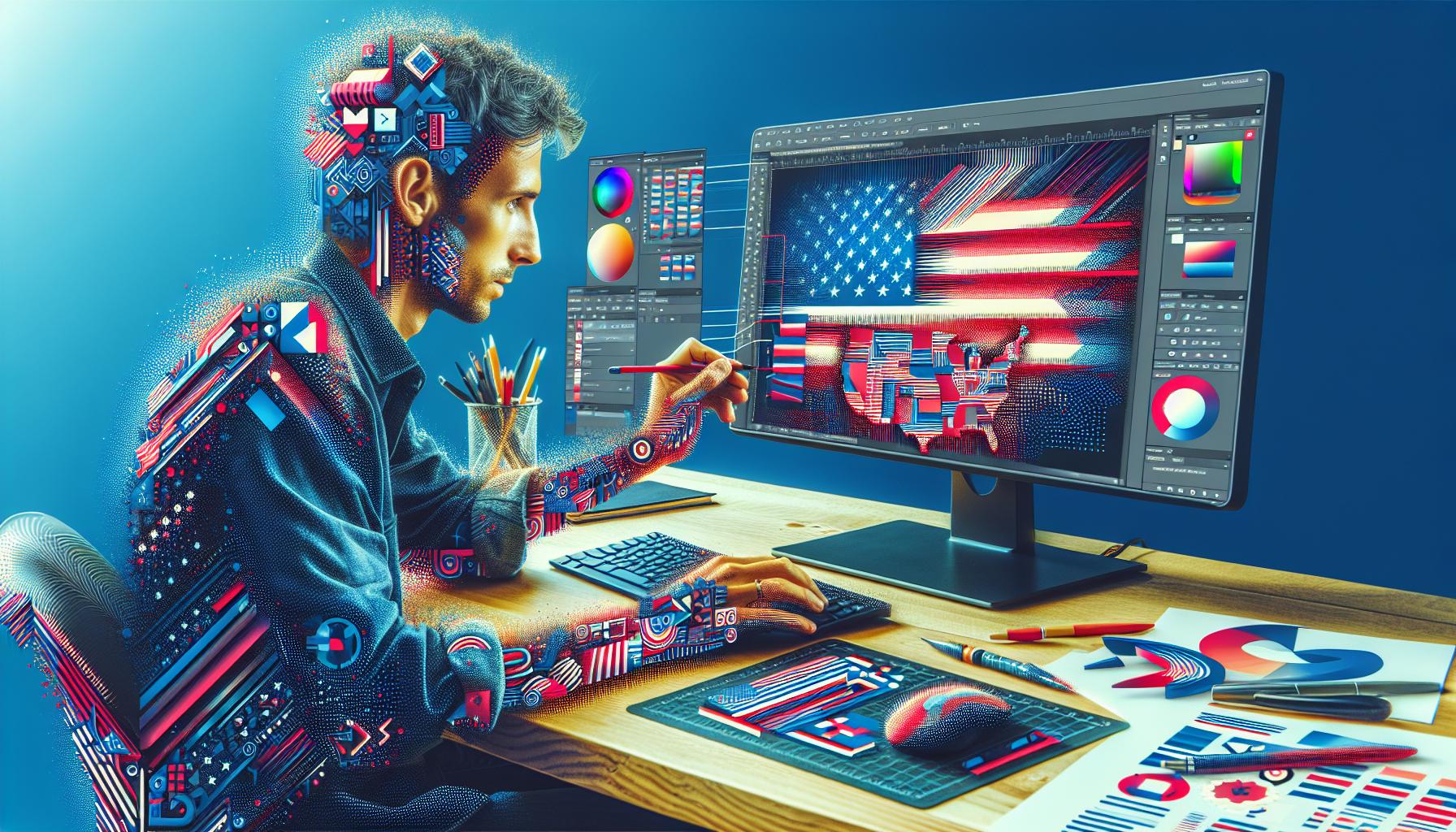Adobe Illustrator is the secret sauce behind some of the most stunning graphics you’ve ever seen. Whether it’s a quirky logo that makes you chuckle or a sleek poster that screams sophistication, Illustrator’s got the tools to turn ideas into eye candy. But let’s face it—navigating this powerful software can feel like trying to solve a Rubik’s Cube blindfolded.
Adobe Illustrator Tutorials Graphic Design
Adobe Illustrator serves as a leading vector graphics editor, known for its versatility in graphic design. Designers use the software to create scalable illustrations, logos, and typography. With a wide array of tools, users can manipulate shapes, colors, and paths with precision. The interface includes panels and toolbars that streamline design processes, making intricate tasks more manageable.
Vector graphics maintain quality regardless of size changes, making them ideal for various applications such as print and digital media. Users find the Pen tool essential for drawing precise lines and curves. Brushes provide different effects, enhancing creativity in designs. Each tool offers unique functionalities that cater to specific design needs.
Learning Adobe Illustrator involves understanding essential features like Layers, Artboards, and the Shape Builder tool. Layers help organize projects, allowing for easy editing and rearrangement of elements. Artboards provide a canvas for multiple designs within one document, streamlining workflow. The Shape Builder tool simplifies complex shape creation, fostering innovation.
For those looking to improve skills, numerous online tutorials exist. Comprehensive resources cover topics from basic techniques to advanced strategies. Engaging with tutorials allows users to explore Illustrator’s capabilities fully. Each tutorial often includes step-by-step walkthroughs that enhance understanding and application.
Regular practice enhances proficiency in Adobe Illustrator. By applying learned techniques to real projects, users reinforce skills effectively. Exploring new tools and functionalities encourages creativity and experimentation. Establishing a strong foundation in Illustrator unlocks endless design possibilities in graphic design.
Getting Started with Adobe Illustrator

Adobe Illustrator provides a versatile platform for graphic design projects. Users should begin by understanding the installation and setup process.
Installation and Setup
Installing Adobe Illustrator involves downloading it from the Adobe Creative Cloud website. After logging in, users can select the application to install. The process requires adequate disk space, typically around 2 GB depending on the operating system. Once downloaded, users can follow simple prompts to complete the installation. After installation, activating the software with a valid subscription ensures access to all features. Keeping the application updated enhances performance and adds new tools.
User Interface Overview
Navigating Adobe Illustrator efficiently relies on familiarizing oneself with the user interface. Upon opening, users see the workspace divided into panels and tools. The toolbar, located on the left, contains essential tools for creating and editing artwork. The properties panel on the right offers contextual options specific to selected objects. Designers can customize their workspace by rearranging panels and saving layouts. Artboards appear as canvases for various designs, providing a clear view of projects in progress. Understanding these elements streamlines the design experience and boosts productivity.
Essential Tools for Graphic Design

Adobe Illustrator provides a range of essential tools vital for graphic design projects. Each tool serves a unique purpose, empowering users to create stunning visuals with precision.
Selection and Drawing Tools
Selection tools like the Selection tool and Direct Selection tool enhance the ability to manipulate shapes. By enabling adjustments to specific anchor points or entire objects, these tools streamline the design process. The Pen tool plays a crucial role in creating custom shapes and paths. It facilitates the drawing of intricate designs through its precise control. For quick shapes, the Rectangle, Ellipse, and Polygon tools allow users to generate basic forms effortlessly. Utilizing these selection and drawing tools enhances overall efficiency and enables designers to execute complex ideas with ease.
Color and Gradient Tools
Color tools, including the Color Picker, enable designers to achieve desired color schemes quickly. This feature allows for accurate color selection, ensuring visual consistency in designs. The Swatches panel offers pre-defined color sets for easy access and application. Gradients introduce depth and dimension, adding complexity to illustrations. Users can explore the Gradient panel to create and customize gradients that enhance visual appeal. By utilizing color and gradient tools effectively, designers can elevate their work, infusing creativity into graphics while ensuring vibrant results.
Beginner Adobe Illustrator Tutorials

Beginner Adobe Illustrator tutorials provide essential knowledge for those starting their graphic design journey. These tutorials guide users through fundamental tasks and concepts that enhance skills.
Creating Basic Shapes
Creating basic shapes serves as the foundation of graphic design in Illustrator. Users can utilize the Rectangle, Ellipse, and Polygon tools for generating various forms. Selecting the desired shape tool allows for quick and intuitive shape creation. After drawing, options for modifying size and position appear in the properties panel. Shape properties such as fill and stroke can also be adjusted for individualized designs. Mastering these basic shapes leads to more complex illustrations as users grow more comfortable with the software.
Designing Simple Logos
Designing simple logos offers an excellent way to apply foundational skills. Beginners can start with basic shapes to form the logo’s structure. Combining multiple shapes allows for unique designs that represent a brand effectively. The Pen tool enables precise control over custom paths, enhancing creativity. Users can also explore color schemes using the Color Picker to establish brand identity. This process highlights the importance of simplicity and clarity in logo design, making it memorable and recognizable. Regularly practicing these techniques helps to build confidence and proficiency in Adobe Illustrator.
Intermediate Adobe Illustrator Tutorials
Intermediate tutorials focus on enhancing graphic design skills in Adobe Illustrator, emphasizing advanced techniques and tools.
Working with Text and Typography
Text manipulation elevates design quality. Designers can achieve nuanced typographic effects using the Type tool, enabling precise control over font styles and sizes. In addition, character and paragraph panels allow customization of kerning, leading, and tracking for optimal readability. Utilizing Type on a Path introduces dynamic text layouts that follow curves and shapes, enhancing visual interest. Exploring creative effects like warping or 3D text adds unique dimensions to projects. Regular experimentation with type treatments develops a designer’s voice and strengthens brand identity.
Creating Vector Illustrations
Vector illustrations form the backbone of digital design. Users can create complex designs by combining shapes through the Pathfinder panel, simplifying intricate illustrations. Mastering the Pen tool unlocks the ability to draw custom paths and shapes with precision. Utilizing the Blob Brush tool fosters a natural drawing experience, allowing for organic shapes and forms. Gradients and pattern fills can be employed to add depth and texture to artwork, transforming simple shapes into vibrant compositions. Consistent practice of these techniques ensures the artist develops a signature style that sets their work apart.
Advanced Adobe Illustrator Tutorials
Advanced Adobe Illustrator tutorials dive deeper into the software’s powerful features. Designers looking to refine their skills can benefit significantly from understanding various advanced techniques.
Mastering Pen Tool Techniques
Mastering the Pen tool involves practicing bezier curves for precise path manipulation. Creating complex shapes becomes easier with this understanding. Adding anchor points strategically allows for smoother adjustments and refined designs. Users can explore techniques like converting points and adjusting handles to achieve desired curvature. Specific challenges can often arise when attempting intricate designs, but consistent practice leads to mastery. Completing exercises focused on real-world applications enhances familiarity. Mastering these techniques ultimately empowers designers to create unique and professional-grade illustrations.
Advanced Image Manipulation
Advanced image manipulation techniques enable users to seamlessly integrate raster images into vector artwork. Employing the Clipping Mask feature allows users to create stunning compositions by masking shapes. Users can also employ Image Trace to convert raster graphics into editable vectors, enhancing design flexibility. Adjustments to color and blending modes refine image integration within projects. Understanding these features allows designers to manipulate images efficiently while maintaining design integrity. Techniques like using filters and effects can significantly elevate the visual appeal of designs. By mastering these methods, designers unlock new creative avenues to enhance their graphic projects.
Resources for Learning More
Numerous resources exist for individuals seeking to enhance their Adobe Illustrator skills. Various options cater to different learning preferences, ensuring that everyone finds suitable materials in their journey to mastery.
Online Courses and Platforms
Various online platforms such as Udemy, Coursera, and LinkedIn Learning offer structured courses focused on Adobe Illustrator. Each course typically contains video lessons, quizzes, and projects. These platforms provide flexibility for learners, allowing them to progress at their own pace. For instance, some courses cover beginner techniques, while others dive into advanced graphic design strategies. Subscription-based services often include a myriad of tutorials updated regularly, permitting ongoing skill enhancement.
Books and Reference Guides
Numerous books serve as valuable resources for understanding Adobe Illustrator in-depth. Titles such as “Adobe Illustrator Classroom in a Book” and “Vector Basic Training” offer systematic guidance for users. Each book presents clear examples and exercises that reinforce learning. Reference guides often include illustrations, tips, and tricks that facilitate quick comprehension. Many professional designers utilize these resources as handy tools for consulting during projects.
Mastering Adobe Illustrator opens up a world of creative possibilities for graphic designers. With its robust features and versatile tools, users can transform their ideas into stunning visuals. Whether one is just starting or looking to refine advanced skills, the wealth of tutorials and resources available cater to all levels of expertise.
Regular practice and exploration of new techniques are key to unlocking the full potential of Illustrator. By embracing the learning journey, designers can elevate their work and establish a unique style that resonates in the competitive graphic design landscape. The journey with Adobe Illustrator is not just about learning software; it’s about unleashing creativity and bringing visions to life.



